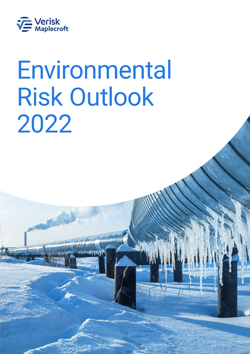Executive summary
Environmental Risk Outlook 2022
by Will Nichols,
As anyone who’s had to deal with the widening array of complex climate risk standards and benchmarks will testify, managing climate change is a complicated undertaking. Yet in many ways, these climate frameworks are too narrow and encourage a siloed view of what is a dense interconnected system of threats. Focusing on the exposure of assets and investments to physical risks or shifts in emissions policy excludes the plethora of secondary political, economic, social, and supply chain risks that are emerging because of rising temperatures and the push towards a low carbon economy. As a result, governments, companies, and investors might feel like they have a handle on how climate change will affect them. But the truth of the matter is, while they have plans in place to address the direct threats, they have yet to scratch the surface of the wider impacts.
Part of the reason why is spelled out in this year’s Environmental Risk Outlook. A blinkered approach to these risk factors is no longer enough. Organisations must take a holistic view of ESG risks that encompasses political threat multipliers like Russia’s war in Ukraine, economic drivers such as the changing face of global energy markets, and the growing human rights and ecological impacts of transition materials. Our geospatial risk data and analysis brings to life some of these key emerging trends to make it crystal clear that companies, investors, and governments able to see the big picture, and act on it, will be best placed to deal with an increasingly uncertain future.
Climate risks begin to spill over
Cascading climate risks are a case in point of the need for a broader perspective. Our analysis shows a world split into three groups of countries based on their resilience to threats triggered by climate change, such as civil unrest, political instability, food insecurity, mass migration, and worsening human rights. Certain economic, societal, and political factors can help insulate nations against these threats. But for countries like Brazil, Mexico or even China, where some of these protections are fragile, susceptibility to cascading risks could intensify. As the severity of heatwaves, storms and floods speeds up, so do the time horizons for rising global instability – raising the stakes for governments, companies, and investors.
Geopolitics starts to bite in clean energy markets
Equally, the burgeoning impacts of Russia’s war in Ukraine on energy markets are still playing out in real time, leaving organisations and governments increasingly exposed to a new range of geopolitical risks and environmental realities. Asia’s response to rising energy security worries has been a return to fossil fuels, casting doubt on the region’s transition away from polluting fuels and enabling national and corporate backsliding on zero carbon pledges. But with Europe pushing for an accelerated transition, China’s stranglehold over green energy manufacturing and mineral supplies is strengthening its geopolitical influence and allowing the country to control the pace of global change.
Scramble for minerals unearths fresh ESG risks
With Russian commodities increasingly off limits – and fears about an over-reliance on China – the EU needs new sources of key materials like nickel, potash, copper, and palladium. As existing sources reach limits, supplies will need to come from poorly regulated markets where ESG risks are less well known, upping the exposure of companies and supply chains to reputational, regulatory, and legal threats. Our Industry Risk Dataset shines a light on potential alternative markets, highlighting how Brazil, the Philippines, Laos, and sub-Saharan Africa are replete with threats to indigenous peoples and the water supplies and biodiversity they rely on.
Weaponisation of environmental regulations
Of course, a burgeoning mining industry could be a godsend for governments looking to boost post-Covid coffers. Increasingly, a small number of countries are mobilising well-intentioned environmental regulations, needed to manage mining industry impacts, as a means to achieve political goals. Ranging from galvanising political support to pressurising negotiations with commercial organisations or even lending a protective veneer to expropriation plans, these moves could be the next resource nationalism battleground. For miners, getting ahead of upcoming policy changes and working to best practice, standard-setting environmental procedures will be vital in avoiding disruptions, closures, or even losses of assets.
